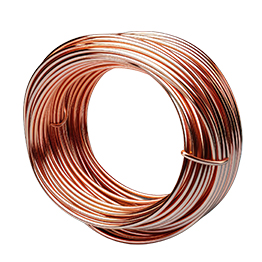
Copper wire is an excellent conductor of electricity, which is why you’ll find it just about everywhere in electrical wiring and components. Thanks to its high electrical conductivity, copper lets electric current flow easily with barely any resistance, moving energy to where it’s needed with impressive efficiency.

We count on copper for everything from the wires in our walls to massive electrical grids. It’s not just about how well it conducts, either—copper’s pretty tough and flexible, so it fits a ton of applications. Plus, it’s reasonably priced for what you get, which is probably why it’s still the go-to in the industry.
So, what is it exactly that makes copper stand out? Let’s dig into why copper keeps winning trust from both professionals and everyday folks.
Why Copper Wire Is a Good Conductor
Copper’s reputation as a top-notch conductor isn’t just hype. There are a few things going on at the atomic level and in real-world use that make it a standout choice.
Properties of Copper That Influence Conductivity
If you look at copper’s electronic structure, it’s got a single electron hanging out in its outer shell. That loose electron is easy to move when voltage comes into play, so copper ends up with high electrical conductivity and surprisingly good mechanical properties.
Pure copper actually sets the bar for conductivity—it’s the International Annealed Copper Standard (IACS), rated at 100%. That’s mostly because copper has low resistivity, so energy loss is kept to a minimum.
Copper also shrugs off corrosion and can be stretched into thin wires without snapping. These perks make it a favorite for copper conductors in wiring, motors, and lots of other electrical gear.
Comparing Copper to Other Conductive Metals
It’s true—silver beats copper for conductivity, but who’s really going to wire a house with silver? It’s just too expensive. Gold’s even better at conducting but, again, way out of budget for most uses.
Aluminum is the main challenger. It’s lighter and cheaper, but it only has about 61% of copper’s conductivity (per IACS). So, aluminum conductors need to be much thicker to carry the same current, which gets bulky fast.
| Metal | Conductivity (% IACS) | Relative Cost | Common Usage |
|---|---|---|---|
| Silver | 105 | Very High | Relays, contacts |
| Copper | 100 | Moderate | Wiring, motors |
| Aluminum | 61 | Low | Power lines |
Honestly, copper just hits the sweet spot: efficient, not outrageously expensive, and tough enough for the job.
The Role of Purity and Annealing in Electrical Performance
When it comes to electrical copper wire, purity’s a big deal. Most wire you see is above 99.9% copper. Even tiny amounts of junk in the mix can drag down conductivity. The industry standard is usually electrolytic-tough pitch (ETP) copper—it’s pure and reliable.
There’s also annealing, which is basically a controlled heat treatment. It softens copper up, making it bendy and less likely to crack when you’re pulling it into wires. Annealed copper keeps its mechanical properties and still nails the conductivity needed for safe, efficient power.
So, yeah, both purity and annealing matter a lot. They’re why copper wires work so well and last so long out in the real world.
Applications and Alternatives to Copper Wire
Copper wires are everywhere in electrical systems, mostly because they balance electrical performance with durability. Alternatives like aluminum and copper-clad aluminum show up in certain situations, but each comes with its own quirks.
Common Uses of Copper Wires in Electrical Applications
You’ll spot copper wires in all kinds of critical electrical and electronic jobs. They show up in the wiring of homes, offices, and factories—pretty much anywhere you need reliable current.
Copper cables are also the backbone of power generation and transmission networks, and they’re found inside computers, refrigerators, electric motors, and telecom gear. People trust copper conductors because they’re predictable and dependable, which is what you want when you’re moving energy or sensitive signals.
In telecom, copper’s purity and flexibility help keep signals crisp. Electronics makers like it not just for conductivity, but also because it plays nice with connectors and is easy to solder.
Copper Wire Versus Aluminum Wire and Copper-Clad Aluminum
Aluminum wire is lighter and cheaper, which is why it’s used for overhead power lines and big distribution networks. The tradeoff? It just doesn’t conduct as well as copper, so you end up needing thicker wires to move the same amount of juice.
Copper-clad aluminum tries to split the difference. It’s got an aluminum core with a copper shell, so it’s lighter and a bit cheaper than pure copper, but still not quite up to copper’s standards for power-carrying capacity or strength.
Here’s a quick rundown:
| Property | Copper | Aluminum | Copper-Clad Aluminum |
|---|---|---|---|
| Electrical Conductivity | Highest | Lower | Moderate |
| Tensile Strength | High | Lower | Moderate |
| Corrosion Resistance | High | Moderate | High (surface) |
| Weight | Higher | Lower | Lower |
| Cost | Higher | Lower | Moderate |
Advantages of Copper Cables for Energy Efficiency and Power Distribution
Copper cables are the top pick for energy-efficient setups, mostly because they’re just so good at conducting electricity and heat. The high conductivity means less energy wasted as heat, so more of what you generate actually gets used.
Copper’s also tough against corrosion and creep, so it keeps working reliably for years—even in rough conditions or with temperature swings. That means less maintenance and longer lifespans for your installations.
With its solid tensile strength, copper resists breakage at connectors and stays put. If you’re working on critical infrastructure, renewables, or high-end electronics, copper’s consistency and quality make it really hard to beat.
Special Types: Stranded Wire, Oxygen-Free Copper, and Connectors
Stranded copper wire shows up a lot when you really need flexibility—think robotics, appliance cords, or those chunky computer power cables that never seem to sit still. Instead of one solid piece, it’s made from lots of thin copper strands twisted together, which makes it bendy and much less likely to snap if you’re moving it around all the time.
Then there’s oxygen-free copper. It’s a bit of a specialty material, with super low oxygen content for extra purity. You’ll see it in places like fancy audio setups or precision telecom gear. Some folks swear it gives you better conductivity and stands up to corrosion a bit longer—maybe a small edge, but hey, in the right context, every little bit helps.
When it comes to connectors and solder joints, copper’s almost always a solid choice. It’s easy to solder and holds up well mechanically, so if you’ve got a good connector design, you’ll end up with snug, low-resistance connections that help keep the whole system running efficiently. Sure, there are some wild alloys and superconductors out there for very specific uses, but honestly, copper’s still the go-to for most people because it just works.

